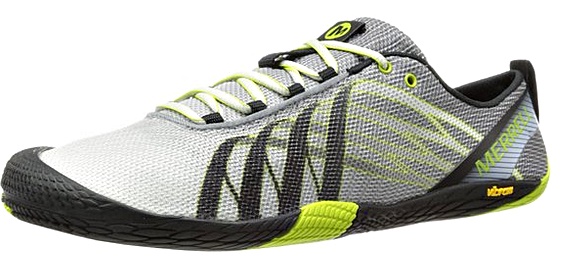If you really struggle with avoiding heel striking and landing on your forefoot when running, minimalist running shoes are one of the best aids in helping you avoid heel strike. This is because minimalist running shoes have no padding under the heel, instead, the entire sole is flat, fully flexible and super thin, which does more to sustainably keep you from heel pounding vs learning forefoot running in cushioned running shoes with an elevated heel.


Most cushioned running shoes are deceptively marketed as safe and essential for injury prevention, however early and recent work (references below article) show that a running shoe with a large cushioned heel puts the foot in a difficult position that causes more rigid landings with a pronounced downward force, and ultimately, can undermine the control of your forefoot strike if you’re not careful. This is one of the many reasons injury rates haven’t declined despite all the advancements in running shoe technology. This is also why the effort needs to put aside adding more cushioning to a shoe because with increased underfoot cushioning you can still be at risk for injury.
In order to get more positive results more quickly in improving your forefoot running form, the barefoot simulating effects of a minimalist shoe provides immediate feedback that guides the direction of your forefoot strike to where it needs to be, while the unrestricted, ergonomic fit keeps your feet strong and tolerant of harder training.
Case in point, a 2015 study in the journal, Footwear Science, which has been confirmed and re-affirmed in the most up-to-date research on the matter, found that runners who trained in a flat, minimalist running shoe, the Merrell Vapor Glove, adopted a forefoot strike landing that resulted in an absent impact transient during downhill, uphill and level ground running. This means that these runners ran without the burst in high collisional impact that occurs in a heel strike landing.


- The researchers compared the ground reaction forces during uphill, downhill and level ground running in habitually forefoot runners who were instructed to train in the Merrell Vapor Glove. The runners were told to train in the Merrell Vapor Glove because of its barefoot-like nature which serves as a proprioceptive (a fancy word for ground-feel) guide to adequate forefoot landing behaviour.
- In contrast, runners who wear thick, cushioned running shoes have a greater tendency to heel strike, generating more impact transients (burst in high impact) during running.
Furthermore, one of the greatest worries in running is running downhill safely. Unlike forefoot running, heel strike running downhill amplifies both the braking force and impact transient.
- The researchers found that during downhill running, the forefoot runners ran with considerably less braking and an absent impact transient than heel strike runners in related studies.
- The researchers concluded that forefoot running, especially in a minimalist shoe that simulates the barefoot running style may be a more effective method when approaching hills.
At the research and anecdotal level, if you look at who gets injured in running, its not the majority of barefoot and minimalist runners, its the majority of runners who wear thickly cushioned heeled running shoes. This is why we need to stop with the universal valuing of thick cushioned running shoes because one of the best ways to develop forefoot running mechanics that stay within a safe range does not start with thick cushioned running shoes. Many examples the research has provided for us affirms that it’s important to feel the ground in order for functional biomechanics to fall into place.
It’s even better that the heightened ground-feelwhen you run barefoot or in minimalist shoes helps you over-learn the forefoot running technique, so that its engrained in your muscle memory, making these low-impact mechanics easily maintained. In that regard, here are more evidence-backed reasons minimalist shoes are incredibly worth your while!
References:
Kowalski E and Li JX. Ground reaction forces in forefoot strike runners wearing minimalist shoes during hill running. Footwear Sci, 2015; 7, s40-s42.
Linares-Martín, J. A; Rico-González, M. Influences of minimalist footwear in middle and long distance runners’ physical fitness, biomechanics, and injury incidence. Strength and Condition Journal, 2023; 45(3):309-24.
Xu, J., Saliba S.A & Jaffri, A.H. The effects of minimalist shoes on plantar intrinsic foot muscles size and strength: a systemic review, 2023. Int J Sports Meds., 2023; 44(05): 320-28.
If you’d like, you can support Run Forefoot and help keep it going by making a donation in any amount of your choosing:

Or, you can support Run Forefoot by shopping at the BEST Barefoot Shoe Brands, and be sure to bookmark these links 🙂
Lonowear: https://lonowear.com/?ref=cedsholh
Saguaro: https://www.saguaro.com/?ref=9bVA8fEkmDvB-I
Vibram FiveFingers: https://www.anrdoezrs.net/click-7600968-11372648
Vivobarefoot: https://amzn.to/3vycQOY
Be Lenka: https://www.tkqlhce.com/click-7600968-13947200
Xero Shoes: https://xeroshoes.com/go/Run_Forefoot
Iguaneye: https://www.iguaneye.com/?ref=8tfXVc92
Soft Star Shoes: https://shrsl.com/3mp1b
Wilding Shoes: https://bit.ly/3lIygQP
Bretta Riches
BSc Neurobiology; MSc Biomechanics candidate, ultra minimalist runner & founder of RunForefoot. I was a heel striker, always injured. I was inspired by the great Tirunesh Dibaba to try forefoot running. Now, I'm injury free. This is why I launched Run Forefoot, to advocate the health & performance benefits of forefoot running and to raise awareness on the dangers of heel striking, because the world needs to know.
Latest posts by Bretta Riches (see all)
- Can You Run In Barefoot Shoes? Yes, But DON’T Heel Strike! - 21/07/2024
- Why Cushioned Running Shoes Are Really Bad for Your Feet - 19/07/2024
- Do Cushioned Running Shoes Cause Injuries? - 17/07/2024


